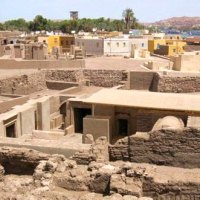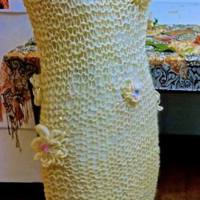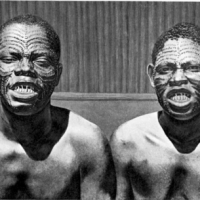Updated 9-11-12
Part II is here:Visitors on the Wild Side of Lake Tanganyika – II
Over the years I have enjoyed (or not) the gifting, invasion, or other means of learning about the creatures of this part of central Africa. Wildlife here in Burundi tends to be on the small side – perhaps in keeping with a small, and now densely populated country.
Snakes. Yes, we have many – most poisonous. Snakes like to come into houses if they can find a way, and often end up in the bedroom.
Several years ago I awakened to the cats frantic hissing, to discover a relatively huge (yes, huge) Black Mamba under the bed.

Black mambas are not always black. They get their name from the inside of their mouth. Source: Nat.Geog.
I called Zac, one of the outside staff, to come to the house to see what we could do with it.
Zac says ‘howdy, what’s up?’ (or something like that, knowing I’d not call him to the house at about 3am unless there was an emergency.
Green Mambas are also bad news. Very poisonous; we have had a few that were seen out where the goats are.
Puff Adders are hugely round, a bit short and also a bit sluggish. But a deadly bite. I once ran over one on the road near the compound, by mistake.
Nile Monitor Lizards are another reptile that is very common here – and although they are cranky and can grow up to 9 feet, they are not dangerous (to people) as long as not cornered – and as long as you’re bigger than a 2-year-old. But they do like small livestock, dogs, cats, chickens, etc.

‘Pet’ monitor lizard. Not a good idea. Source: zoo2you
Smaller ones that the above picture have from time to time climbed trees overhanging one of our goat houses, preparing to lunge down for the kill. Usually the dogs announce the presence of a monitor lizard, and the workers then chase it about hoping to catch and kill it – the flesh is very good, according to locals. A bit like chicken.

This is the size we normally have around here – a good size for roasting. Source: http://www.abdn.ac.uk
There are also beautiful colored lizards such as this one:
During the rainy season one sometimes finds very strange frogs – at least not so common, like the following, who actually made it into the house.
Moths and butterflies – not so many. This Night Moth I found inside of the house a while back:
In the past, there were various animals that now have disappeared, or are close to disappearing, including the following –

Two chimps that lived at the Hotel Club du Lac Tanganyika, whom I looked after, until they became too large for their enclosure and we donated them to the local wildlife sanctuary. Here, I have just given them some popcorn, which they loved as a treat.

In former times, leopard skins were appropriate wear for princes and notables. Prince Bishinga, c. 1910. Source: Meyer – Les Barundi
Throughout the Great Lakes region of central Africa the wearing of leopard skins was so carefully ascribed only to royalty or elite, that Speke records in one of his travel books of the mid-Nineteenth Century that a young fellow appearing at their camp in the area of Lake Victoria wearing a leopard skin was quickly and roundly chastised. He was trying to pass himself off as the son of a local leader – which he was not.

Elephants, too, were to be found in times past, though apparently not many. Most elephants lived to the west of us – in the Congo. The last elephant seen near us – in the Rusizi Wetlands, down the lake – was in the 1970’s. Source: shutterstock.com c. 1960’s.
Part II is here: Visitors on the Wild Side of Lake Tanganyika – II
Related articles
- Discovering the Rusizi River, Did it flow IN or OUT?! Part VI (dianabuja.wordpress.com)
- It’s That Time of the Year Again: Rice Harvesting and Processing (dianabuja.wordpress.com)
- Discovering the Rusizi River, Did it Flow IN or OUT?! Part III (dianabuja.wordpress.com)
- 5 Deepest Freshwater Lakes (5facts.org)
- Lessons in Pasta-making at the Hotel Lac Tanganyika (dianabuja.wordpress.com)
- What Happened to the Black Mamba in the Bathroom (dianabuja.wordpress.com)





































Pingback: Christmas Celebrations at the Hotel Club du Lac Tanganyika | DIANABUJA'S BLOG: Africa, The Middle East, Agriculture, History and Culture
Wow, I like snakes but I would not enjoy waking up and finding any venomous snake under my bed – never mind a black mamba. I suppose you get used to such creatures, but when I see a green mamba at the local zoo here in the US I get the heebie-jeebies! Interesting pictures, though.
LikeLike
No, it was not a welcomed experience and I have the vision of the snake curled up under the bed as a ‘photo’ in my mind. Happily the cats alerted me and at the same time did not try to attack it! Glad you’ve enjoyed the pix and hope to see you again back here!
LikeLike
Pingback: A Taste of 2012 – Top Posts Favor Colonial Era; Food; Ancient Egypt | DIANABUJA'S BLOG: Africa, the Middle East, Agriculture, History & Culture
Pingback: An African Christmas, Burundi-Style | DIANABUJA'S BLOG: Africa, the Middle East, Agriculture, History & Culture
Pingback: Artist-in-Resident at the Hotel Club du Lac Tanganyika: Art Helping Kids in Africa | DIANABUJA'S BLOG: Africa, the Middle East, Agriculture, History & Culture
Pingback: Another Black Mamba Gets in the House | DIANABUJA'S BLOG
Pingback: Visitors on the Wild Side of Lake Tanganyika – II « Dianabuja's Blog
Pingback: The Life of Monitor Lizards along Lake Tanganyika « Dianabuja's Blog
Our usually really don’t depart remarks yet this for you to be these times! Our bookmarked web page about reddit!
LikeLike
Andre – I don’t quite understand your email! Can you clarify? Thanks.
LikeLike
Pingback: mamba « Мысли блогеров всего интернета